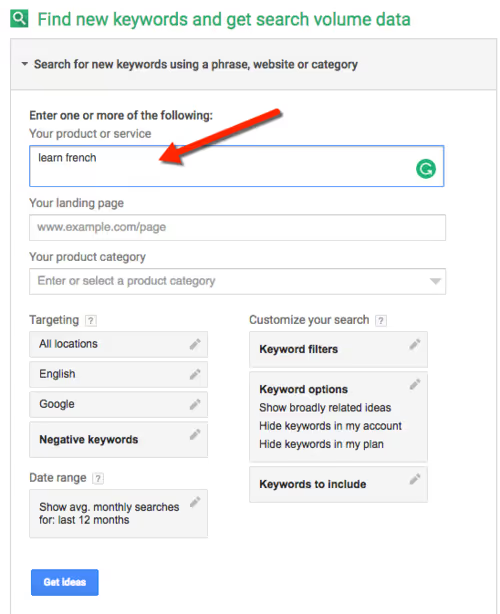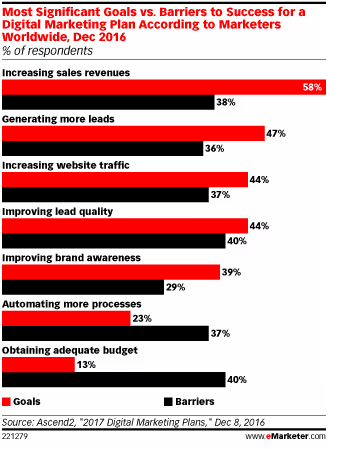.avif)
Imagine your name is Jacques and you work as the Director of Marketing at Le Hamburger Institute. Le Hamburger sells French language courses online and competes against other online education companies such as Rosetta Stone, Babbel, Pimsleur, and Fluenz.
Your objective is revenue growth, but only 75% of your proposed digital marketing budget has been approved.
So you can achieve that objective, you have to convince senior leadership that they should approve the remainder of your budget, which allocates resources to a new marketing strategy for your company–using paid search channels (aka SEM or PPC).
You are certain that SEM will be the next big marketing channel for your E-Commerce business, but you need to get senior leadership on the same page to get a final approval for the budget.
What do you do?
LE HAMBURGER INSTITUTE
Remember Freddy Rumsen from Mad Men? He was an old-fashioned senior copywriter who got drunk and pissed his pants before his big pitch.
If you take Freddy’s approach, you might read a few blogs, gather some anecdotal evidence and think you’re prepared to make a strong pitch.
But, like Freddy, you don’t have concrete data and a clear plan to present to senior leadership. Someone starts asking questions about the numbers supporting your plan, you don’t have good answers.
Shit hits the fan and your idea will get shot down on the spot.
DON’T FORGET THE DATA
At SCUBE, we see it happen again and again. Businesses invest in the new digital advertising channels without the due diligence for the viability of the marketing channel.
Their company ends up doing a lot of work, spending a lot of money, getting into long-term agency relationships and realizing that there was never an opportunity for their product.
DON’T REGRET FOR SKIPPING DUE DILLIGENCE
I know you are smarter than this. In fact, I think you’re probably more like Peggy Olson than Freddy.
You probably remember Peggy Olson from Mad Men, who went from a secretary to the copy chief because of her work ethic. If you’re like Peggy, you will do your homework and develop a good plan–one based on data.
Today there are more marketers like Peggy Olson. Robert Allen, one of the digital marketing gurus at Smart Insights emphasizes that 77% of marketing professionals think a planned approach focusing on analytics and continued optimization is the most effective way of managing digital marketing. Only 14% think a relatively unplanned, reactive approach is best.
“Let’s form a hypothesis, challenge it with data, then make better decisions and do better marketing.
— Andy Crestodina, Strategic Director at Orbit Media
A plan based on data analysis gives you facts.
Whether good or bad, facts are facts. If the facts support your objectives, your senior leadership team will have no choice but to sign off on your budget, and you will be off to the races to implement the paid search program and start a “baller walk” around the office like Peggy Olson.

Baller Walk (via Giphy)
Ready to roll up your sleeves and develop a monumental E-Commerce PPC marketing strategy for your company? There are 5 steps you can’t miss.
First, think about the objective. No PPC strategy should start without a clear objective.
Most E-Commerce marketing leaders are interested in sales growth and high ROI.
Obviously, this is the end goal. Easier said than done.
HubSpot’s State of Inbound annual report reveals that traffic generation, lead generation and proving ROI are the biggest concerns in today's marketing.

That’s why you need to be more strategic in your approach by clarifying your SEM objectives and breaking them down:
Remember, your objectives determine the metrics you measure. Here is the list of metrics associated with the goals:
Customer Lifetime Value (CLV)
CLV is one of the most important metrics to use, so I will put it in a separate category. Many E-Commerce businesses are calculating ROI on one purchase and it is one of the common mistakes that E-Commerce companies are making, according to Jaime Brugueras, VP of Customer Success at Networked Insights where he leads the analytics team. CLV, on the other hand, helps predict profit for an entire future relationship with a customer.
Since the metrics are misaligned, these companies rarely focus on maximizing the customer lifetime value. Here is the formula developed by Edward Gotham:
CLV = T x AOV x AGM x ALT
Where:
T = Average monthly transactions
AOV = Average order value
ALT = Average Customer Lifespan (in months)
AGM = Average gross margin
CLV applies to all objectives, because the higher the number, the more room you have to play to acquire new customers.
Lead Generation Metrics
Customer Acquisition Metrics
Customer Retention Metrics
Le Hamburger sells online courses at $200 each. On average their customers buy a new level course every 6 months and buy 5 courses throughout their lifetime. Le Hamburger’s gross profit margin is 60%. Here is the breakdown for our CLV formula:
T = 2/12 = 0.1667 transactions/month
AOV = $200
ALT = 30 months
AGM = 60%
CLV = 0.1667 x $200 x 30 x 60% = $600
Now that you know you can spend up to $600 to acquire one customer and still break even, you can set some boundaries for each objective:
Lead Generation Metrics
Customer Acquisition Metrics
Paid search is driven by people searching for things. Therefore, it has its limitations. It fulfills demand. If no one is searching for what you have to sell, there is no demand.
However, don’t make the mistake of limiting your opportunity to one stage of the buyer’s journey. There are generally three stages and here is how they differ:
Start your keyword research using one of the following three ways:



Once you have a decent list, don’t keep the pile of search terms lumped together. Break everything into products / product categories, so you can make more granular decisions. Then start mapping common keyword themes to the stages of the buyer’s journey. This will allow you to quickly understand your keyword coverage by each stage.
Watch out for intent bombs during your keyword research. What are intent bombs? They are high-volume search terms that aren’t intended for your business but could be triggered by relevant keywords.
For example, the main keyword for Le Hamburger is “Learn French”. However, it will also trigger “Learn French Kiss” search term. You don’t want your paid search ads to show up under “Learn French Kiss” search terms when you are selling French language courses.

Learn French Kiss (via Giphy)
What can you do about it? Add negative keywords during the research process to exclude words or phrases that change the intent of your search terms.
Le Hamburger has only one product type - online course for learning french language. So you have to brainstorm different ways potential students are searching for a french language course.
You identified three steps for the prospective Le Hamburger buyer:
Then based on three stages, you organized your keywords into campaigns and ad groups. This helps you have a more granular view of your keyword opportunity list and structure ideas more strategically.
When looking into the search volume, don’t have a pile of search terms lumped together. Break everything into products / product categories and buyer’s journey segments, so you can make more granular decisions.

Bonus Tip: Align Your Offer and Expectations for Each Stage
When considering a PPC channel, you have to evaluate the opportunity at each stage and set the right expectations at each stage.
At each Buyer’s Journey stage, you have to help your buyers achieve their objective, so they can move to the next stage. For example,
Your opportunity is limited to the search volume of the keywords you are targeting.
Your search volume will come from targeting 5 factors:
All factors contribute directly to the total opportunity and are interrelated to each other. You can manipulate them, but you will be confined within their boundaries.
Start with the main metric on the search engine - Search Volume.
Once you have search terms and their search volume, you can estimate the other metrics for your search opportunity. Continue with the following metrics:
Add each segment and product categories to get to the total. Now you have an estimate of the total market opportunity for your target audience, traffic to your website, monthly budget, orders and cost per order.
This is your opportunity.
Let’s break it down:
Based on the factors above, you gather the search volume for the list of chosen keywords, summarize them at the Ad Group level, then Campaign, and Buyer’s Journey segment level.
Voila! You have a table with your total PPC channel opportunity.

Knowing your paid search opportunity is great, but knowing how it aligns with your business objectives is even more important because the economics will dictate your decisions.
Time to go back to step #1 and evaluate how the numbers align with your company’s objectives.
IT’S ABOUT THE ECONOMICS
Where do we start? You have three levels of analysis:
After your analysis is done, expect to eliminate some campaigns and ad groups from your initial opportunity list. The remainder will go to the next step - budget decisions.

The final consideration is the budget. It is almost always limited and you have to fight for it.
I have a 90% guess, that your SEM opportunity is higher than your budget.
This is usually the case with most E-Commerce marketers. December 2016 E-Marketer study shows that the biggest objective for digital marketers is the increase in revenue and the biggest obstacle is obtaining the adequate budget to achieve the objective.

When the PPC budget is limited, you have to prioritize it. Here is how:
Le Hamburger has $50,000/month to spend on a new channel. Here is how to allocate it based on the analysis above:

Time to step out of Jacques from Le Hamburger shoes and get back to your business. If you plan to launch a new E-Commerce paid search ads program or expand an existing one, use the concepts and examples above to develop a clear strategy.
You will gain clarity about your business and marketing objectives and the numbers will back up your ask for a bigger marketing budget.
I Want to Hear From You
If you have launched a paid search program before, what was the most important step in the process?
Let us know in the comments.